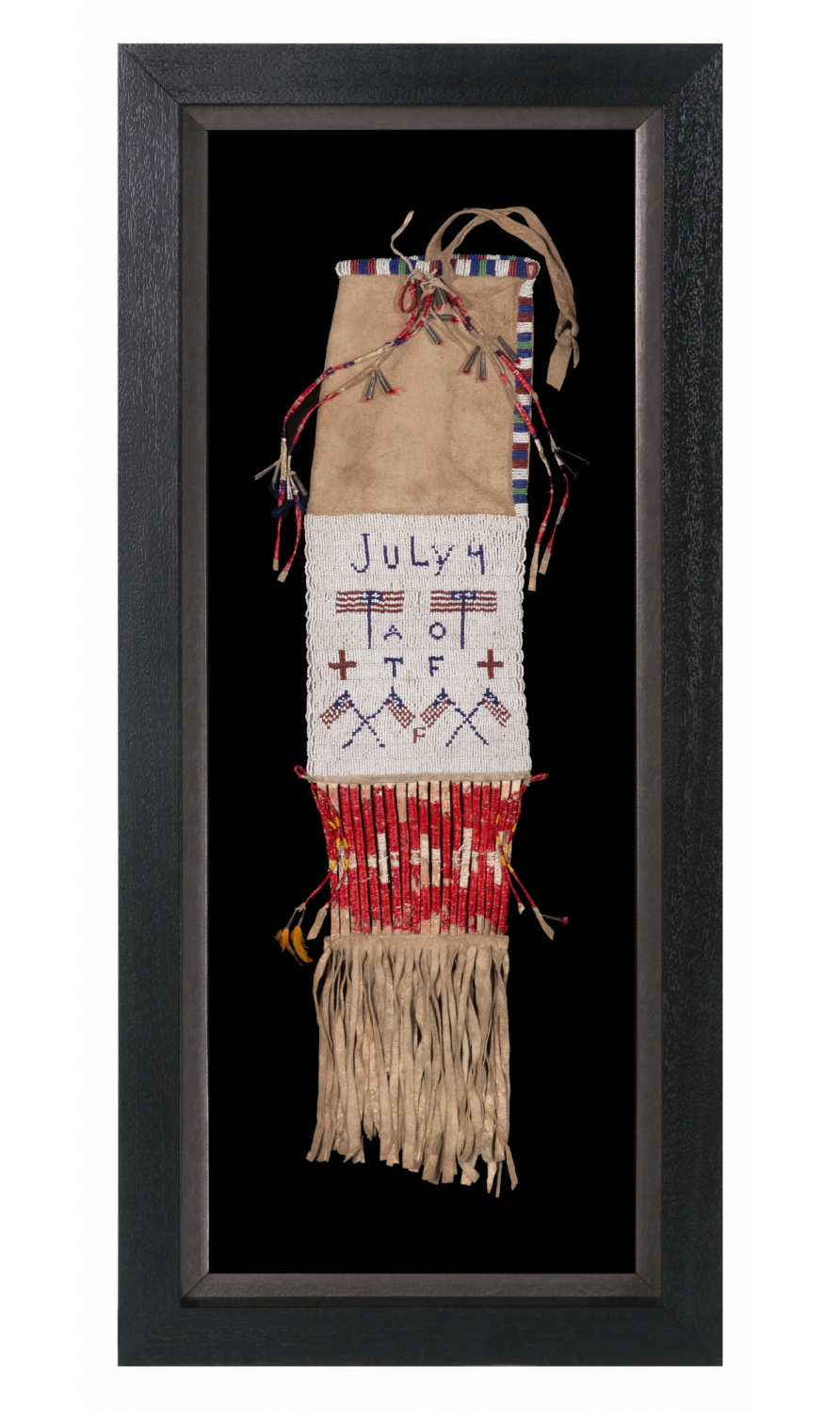


| PATRIOTIC, NATIVE AMERICAN, BEADED & QUILLED PIPE BAG w/ AMERICAN FLAGS AND THE VERY RARE INCLUSION OF THE DATE "JULY 4th," ALMOST NEVER ENCOUNTERED ON EARLY TEXTILES OR INDIAN BEADWORK, PROBABLY SIOUX, circa 1890-1910 |
|
| Web ID: | pat-657 |
| Available: | In Stock |
| Frame Size (H x L): | 42" x 17.5" |
| Flag Size (H x L): | 29" x 7" |
| Description: | |
| American Indian pipe bag, made of deer hide, with various forms of decoration and a patriotic theme. The design is centered on a panel of red, white, and blue beadwork with back-to-back and crossed representations of American flags. The background is white. Along the top, in blue, is the prominent date of July 4th. In the center, also in blue, are the initials “AOTF”, with red crosses flanking to the left and right. In the bottom center is another “F,” this one in red. The upper portion of the bag is trimmed with red, white, blue, and green beadwork. Decorative straps are wound with painted porcupine quill and adorned with tin cones stuffed with dyed chicken feathers. More of these appear at the bottom, which displays vertical staves, made of parfleche, and wrapped with porcupine quill, followed by a long, hide fringe. Parfleche (thinly stretched hide, usually buffalo) was traditionally employed to make envelope-like receptacles. Individuals would use these to carry dried meats and other food items, such as pemmican. These were typically painted in bright colors. The term parfleche was actually used much more loosely for all manner of rawhide objects made of the material. Parfleche underlay for an article such as this breastplate was often recycled. That is the case here. Exposed areas of the rectangular staves exhibit paint decoration from the previous item that the hide was used to create. “AOTF” is an acronym for the “Ancient Order of the Foresters” (more often represented by simply AOF). This was a friendly society / fraternal organization that grew out of the Order of Foresters of England, begun sometime during the 17th century. Like many other fraternal groups of the time, its fundamental role was to care for the sick, providing both sick and death benefits to its membership, in a period before social services and affordable insurance played such a key role in society. Because the English thrown outlawed any organization of common, working men, these were, by necessity, secret societies. The legend of Robin Hood giving to the poor grew from this circumstance, hence the Foresters name. Early on, members actually fought with various weapons to obtain membership, including wooden quarter staffs and swords, in a ritualized fashion. This was abandoned in 1843. The Foresters expanded to the U.S. (New Jersey) in 1874. Just one year later, in 1875, the movement was taken to Canada by Native American, Mohawk doctor and community leader, Oronhyatekha, who became “Supreme Chief Ranger” (its highest officer) in 1879, serving until 1906. By that time there were more than a quarter of a million members in Canada alone. Oronhyatekha (Burning Sky) had been baptized with the given name “Peter Martin,” after which he attended Oxford and earned his medical degree. Prospective members had to pass an examination by a competent physician, who was bound by his own connection to the order. So many physicians were involved as a rule, hence the red crosses. It seems very likely that this bag was made specifically for a AOTF doctor. The red “F” below the crossed flags either emphasized the primary initial for “Foresters” or perhaps the name of the recipient. It is of interest to note that this bag was made around the time of Oronhyatekha’s tenure. Interest in the organization among Native Americans probably grew substantially due to the involvement of this prominent elder. Mounting: The bag has been carefully hand-stitched to its background, which is made of 100% cotton twill, black in color, that has been washed and treated for colorfastness. The mount was placed in a black-painted Italian molding with a deep, rectangular profile, to which a rectangular molding, with a finish like old gun metal, was added as a liner. A shadowbox was created to keep the object away from the glazing, which is U.V. protective acrylic. Condition: Some soiling and oxidation. There is some breakdown in the quill with associated losses (readily apparent). |
|
| Video: | |
| Collector Level: | Advanced Collectors and the Person with Everything |
| Flag Type: | |
| Star Count: | |
| Earliest Date of Origin: | 1890 |
| Latest Date of Origin: | 1910 |
| State/Affiliation: | |
| War Association: | |
| Price: | $12,500 |
| E-mail: | info@jeffbridgman.com |
 |
|